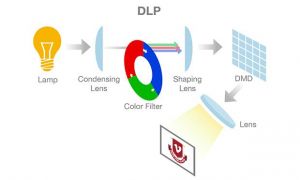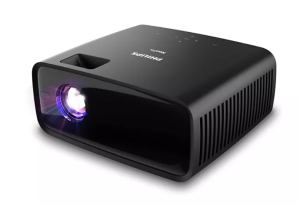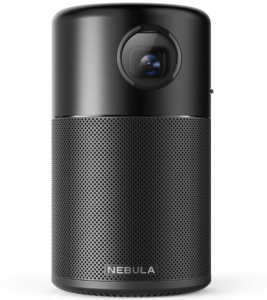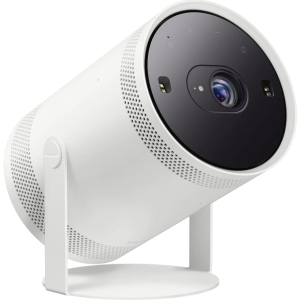Projectors may seem like a luxury item to purchase for a home cinema, but as they become more popular, they could just overtake a standard TV for home entertainment systems. There are three main types of projectors to choose from giving you plenty of options for how and where you want to set up your entertainment space. This guide breaks down the ins and outs of projectors and can help you decide whether they are your next home entertainment purchase.
How does a projector work?

A projector is an optical device that physically projects an image or series of images onto a flat surface. Common projectors shine light through a set of transparent lenses to effectively create and reflect the image, while newer models use laser technology to bolster image quality, although how projectors reflect light is dependent on the type.
The brightness of projectors is integral to the quality and is measured in what is known as lumens, with different environments requiring differing lumen levels for optimal viewing quality. For home theatres or darkly-lit areas, at least 1,500 lumens are required, while for conference rooms, class rooms and other brightly-lit areas will require a minimum of 2,500 lumens.
Types of Projectors
While all projectors may essentially do the same thing, there are a few key differences to note that may help you find the best option for your viewing needs. Below is a breakdown of the common types of projectors you’ll find.
LCD Projector
LCD, also known as Liquid Crystal Display, is a type of projector display that comprises of three panels, each coloured red, green or blue, which create the full palette of colours for the projector’s image once a light is shone through. LCD projectors traditionally have a better colour saturation as a result and tend to be a standard choice.

DLP Projector
Also known as DLP, Digital Light Processing is arguably the most popular type of projector, and is widely used in movie theatres. DLP uses a collection of miniature mirrors to reflect light, with a built-in rotating colour wheel used to reflect the colour onto the screen. Due to their popularity, DLP projectors are argued to be better than LCD models at capturing contrasts and shadows.

Portable Projector
While some projectors are screwed into the wall or ceiling, other models are designed to be more portable so that you can take your movies or presentation with you on the road. These models are becoming more popular, and are generally available as either a DLP or LCD variants. Some require charging for an internal battery or to be plugged into a wall depending on how long you wish to use the appliance. While they may not offer the same quality, it may be more convenient to use, with some models small enough to be thrown into your backpack to be taken on the go.
How much do projectors cost?
Projectors retail between $200 and $6,000 depending on the model, brand, size and features. Cheaper projectors will generally be smaller units with a lower quality of projection that can be used in smaller spaces, whereas premium models can be used to project larger images at a higher quality. Very top of the range projectors will cost upward of $5,000 whereas good quality or middle of the range projectors will sit below $1,500.
Which brands sell projectors?
There are a number of brands that sell projectors at varying price points. Popular brands that sell projectors include Philips, Nebula and Samsung, who have a number of models available on the market to suit different needs.
Philips projectors

Philips are a well-known appliance brand that sells TVs, kitchen appliances, and projectors. Its range of projectors retail between $200 and $1,000, offering varied price points for different budgets. Many of its projectors are said to boast a built-in power pack with battery for portability, up to three hours of entertainment and a crisp built in speaker with a mini-HDMI for external dongles to connect phones and laptops.
Nebula projectors

Nebula projectors come in at a slightly higher price point in the portable projector market, which its entry-level model retailing around the $400 mark. They’re a compact and modern looking projector that can be taken wherever you want to set up your on-the-go cinema. Key features include a generous 20×100 inch projection screen, a 360-degree speaker and Android 7.1 programming to play content from your favourite video streaming apps.
Samsung projectors

Samsung offers a range of portable and laser projectors ranging from $1,000 to $6,000. At a more premium price point you can expect features including immersive 360-degree sound, 4K resolution and cutting-edge laser technology for crisp and clear visuals. The portable projectors also offer the option to customise colours on the external unit to suit the décor of your home or entertainment room.
What to consider when buying a projector
When looking to buy a projector, there are some key factors to consider to help make the process simpler.
- Type of projector: With LCD and DLP projectors working slightly differently, it’s worth looking into what you plan on using your projector for. If you’re looking to primarily watch movies with it, you may prefer a model with a richer colour contrast, while you may not have to worry about that as much if you’re simply looking to showcase a presentation at work.
- Lighting: With the picture quality dependent on the lumen count and outside light, it’s best to consider where you plan on using your projector in order to find the best fit for your needs. If you’re looking to set up in a home theatre with minimal lighting, a lower lumen count may be what you need, while if you’re potentially presenting at work, you may need a higher lumen count to help get the message across.
- Installation: If you’re looking to create a home theatre in your house, you’ll have to consider more than just the projector, with the installation process an important, and sometimes tricky, area to consider. As a result, it’s best to consult with either an electrician or the brand directly in regards to the best practice on how and where you can install a projector in your home.
- Cost: As with most purchases, the price tag can often sway the decision, meaning it’s best to look into all of your options before you decide to part ways with your cash. By researching brands, models and retailers, you may find a model on special, meaning you can spend more on snacks for movie night.
Is a projector worth it?
Finding the middle ground between work and play, projectors can also be a more affordable option in comparison to modern TVs, allowing you to settle in for movie night just about anywhere. But with plenty of brands, types and models available, it’s best to look into all of your options before purchasing, particularly if you’re looking to get a model installed into your wall or ceiling. Compare home theatre systems to create the ultimate cinematic experience in your home.
Photo Credit: OverdoseStudio/shutterstock.com, Evgeny Atamanenko/shutterstock.com, Manuel Findeis/shutterstock.com, Vimeocdn.com, FrameStockFootages/shutterstock.com



Share this article